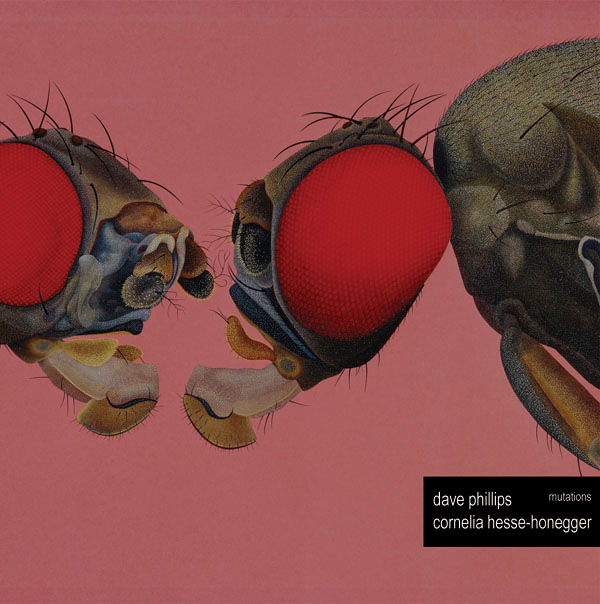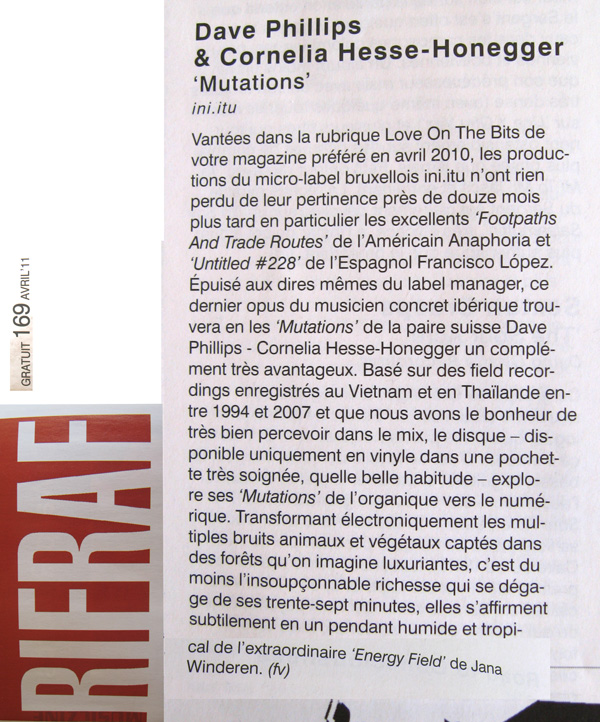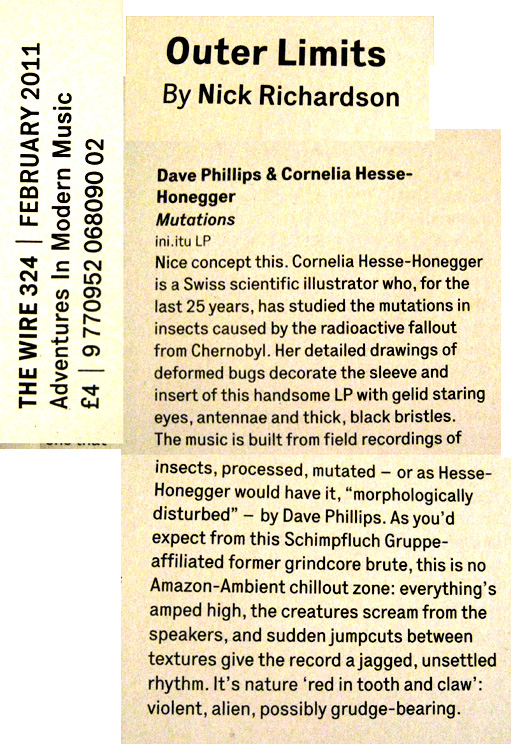
 |
|
by Héctor Cabrero on Le son du Grizzli jan 2012 |
Le camion que l’on entend passer est un poids-lourd chargés d’insectes. Ces créatures sont l’œuvre du diable – un diable né d’une collaboration entre une scientifique qui rapporte les mutations subies par des insectes touchés par le nuage radioactif de Tchernobyl (Cornelia Hesse-Honegger) et un ex-musicien de grindcore (Dave Phillips).
|
by Phillip "PBK" Klingler on Killing Birds nov 2011 |
An astonishing work of art recorded by Schimpfluch Gruppe member, Dave Phillips,with paintings and inspiration provided by Swiss scientific illustrator,Cornelia Hesse-Honegger. This album is packed with amazing sounds from start to finish! Recorded by Phillips in Thailand, Vietnam and his home of Switzerland between 1994 and 2007, the field-recordings already provide a tremendous personal diary, but then through "mutations" the stories in the sounds are transformed by Phillips into metaphor for some kind of microbial sound world, in this case the most likely correlation(via the eye-popping artwork of Ms. Hesse-Honnegger) are insect habitats. The noises here, clickings, pops, whistles, animal/bird sounds, howling, jabbering, sawing, wind, etc- while listening to this surrealist melange I can't help but wonder if every sound on the album could just as well have been made by Phillips' own voice? But their origin doesn't matter in the end, as he has transformed these sounds with great mastery into one of the most compelling albums I have ever heard! There are jarring moments here, but it's not a typical noise album, those moments provide drama, even a fearful element that creeps in. It's absolutely visual, but what you visualize is so bizarre as to destroy any preconceptions. As with most of Ini.Itu's output, this album is also mastered by James Plotkin and the sound is fantastic. This definitely makes my Top Ten list for 2011.
|
by Ian Holloway from Wonderfull Wooden Reasons ( august 2011 ) |
Dave Philips is a Swiss sound artist working here in transfigured field recordings. The music is deeply engrained in the natural world and the various sounds captured "in national parks, forests, fields, swamps, caves, by rivers, on lakes, under trees etc., in Thailand, Vietnam and Switzerland" have been sympathetically woven to produce a faunal tapestry of stunning complexity.
|
by Ed Pinsent, on Sound Projector #20 (sept 2011) |
... |
by Scott Foust from Swill Radio ( september 2011 ) |
Cornelia Hesse-Honegger is a scientist who has done research on the effects of radiation on insects. She is also an interesting artist and she did the lovely paintings of mutated insects which adorn the cover and insert. Dave Phillips did the music which consists of collaged and mutated field recordings made in Thailand, Vietnam, and Switzerland. The music is superb. Two side long collages of insect and nature sounds that sometime build to a startling, almost electronic, intensity. This is just the way I like my insects, contained in an art object where they cannot invade my airspace, run on me, or bite me. The usual very beautiful Ini.Itu cover and presentation.
|
by Fabien from Liability Webzine ( august 2011 ) |
Cela n'aurait pu être qu'un disque d'exotica conçu à partir de field recordings qu'on aurait rien eu à redire. Cependant, l'approche proposée par Dave Phillips (Fear of God, Ohne) et Cornelia Hesse-Honegger se veut un peu plus brutale. Ce n'est pas pour rien que ce disque s'appelle Mutations. Construit autour de sonorités récoltées en Thaïlande et au Vietnam entre 1994 et 2007, le duo a fait plus que les associer et les traiter électroniquement. Ils les ont déformé, maltraité, créant des distortions diverses. Nous sommes donc très loin d'une musique appaisante et des idées toutes faites que l'on se fait sur le genre. Ici nous sommes dans le noise, une forme abrupte et frontale qui désacralise une musique que l'on sait trop sereine. Nous avons donc bien affaire avec une mutation mais pas de celle que l'on attend forcémment. On revient à un état sauvage, qui se transforme ou plutôt se déforme comme si les sons de la nature collectés se noyaient dans une entreprise de démolition bruitiste. Insectes et oiseaux exotiques semblent se fondre dans cet amas post-industriel mais l'expérience est parfois difficile à suivre. Il faut donc s'accrocher, combattre sa répugnance au bruit et prendre ce Mutations comme du field-recordings extrêmen qui bouscule les habitudes. En un sens, c'est quelque peu salvateur. On sort ainsi du flon-flon trop serein dans lequel on était trop souvent plongé. Il serait facile d'interpréter ce disque comme une réaction épidermique aux dogmes du field-recordings. En soit, Mutations n'est pas une provocation bruitiste à la Whitehouse. Bien au contraire, ce disque se révèle comme une expérience afin d'emprunter des chemins différents et s'offrir des perspectives nouvelles. De plus,Mutations n'est pas dans un affrontement total. Malgré ses penchants noise, ce disque reste tout en nuances et ces subtilités ne se révèlent à nous grâce à une écoute attentif et studieuse. C'est là que le sens du titre de l'album devient évident. Nous n'avons pas affaire à une mutation unique et stérile mais à «des» mutations qui, lorqu'elles entrent en contact, en provoquent de nouvelles. D'où cette impression de foisonnement, de superposition sonore qui nous laisse ce sentiment de bruit incontrolé. Ainsi, Mutations atteint son but et nous dévoile une musique qui sort des sentiers battus.
|
by Seb Bassleer in Gonzo Circus' website ( feb 2011 ) |
Ini Itu is een ons nog vrij onbekend label, opgericht in Jakarta in 2008 en sinds enige tijd gevestigd in de Brusselse buitenwijken van Schaarbeek. Het doel van het label; het uitbrengen van specialere geluidsstructuren op vinyl LP's in gelimiteerde oplages van 250 stuks. Geen cd's, mp3's of andere vorm van duplicatie dus en daarmee weten we direct dat we te maken hebben met gepassioneerde mensen met een innige liefde voor de zwarte groef. [...] Dave Phillips enCornelia Hesse-Honegger slaan de handen ineen voor 'Mutations', de ene als geluidsartiest, de andere als visueel artieste. Het concept hier zijn de onnatuurlijke mutaties van gevleugelde insecten ten gevolge van de Chernobyl kernramp. Geluidsopnames van insecten in Zwitserland, Thailand en Vietnam zijn in collagevorm samengesteld en aangevuld met donkere tonen en drones. Insectenelectronica dus en bij audiofielen zal het water nu wel in mond beginnen te lopen. Het is een intrigerende geluidstrip van gemuteerde geluiden uit de natuur waar onheilspellende sferen de boventoon voeren. De wereld van insecten is en klinkt onmenselijk, dat is zeker. Geen lol maar wel sterke geluiden. Een goed detail; beide platen werden gemastered door James Plotkin. Ini Itu heeft ons goed wakkergeschud en we zetten onze radar richting Schaarbeek.
|
by Fabrice Vanoverberg in Rif Raf #169 ( avr 2011 ) |
 |
by Nick Richardson in The Wire #324 ( feb 2011 ) |
 |
by Doug Mosurock from Still Single ( feb 2011 ) |
HEAVY field recording/manipulation of Thai and Vietnamese sound sources by Fear of God’s Dave Phillips, augmented by scientific illustrations of mutated insects by artist Cornelia Hesse-Honegger. Her work graces the cover art, labels, and full-color plate within, and gives a striking but a bit too obvious of a meaning behind Phillips’ sound collage, which is why you probably stepped up in the first place. Sounds of insects, nature, voices and machinery are slowed down, phased heavily, and stretched into ominous tones that somewhat remind of Basil Kirchin’s groundbreaking Worlds Within Worlds albums from the early ‘70s, though the passage of time and accrual of experience within the horrors of society/the world/popular culture has brought the dread down hard. Phillips takes this experience and places it, boot-like, directly upon the listener’s throat, the menace within these sounds growing steadily as the sides grind on. Outstanding, oppressive, hot work from both science and creation. Edition of 250 numbered copies.
|
by Textura ( feb 2011 ) |
Sound sculptor Dave Phillips and visual artist Cornelia Hesse-Honegger pool their talents for the thirty-seven-minute vinyl release Mutations (available in 250 hand-numbered copies). Though the Zürich, Switzerland-based Phillips has a background in grindcore, doom-metal, and other radical sound ventures, his recent work has focused more on field recordings of animal sounds, while Hesse-Honegger, a scientific illustrator for twenty-five years at the University of Zürich, has been painting leaf bugs for many decades, and since the Chernobyl explosion, has been studying the mutated morphology of insects found in radioactive regions. As a collaborative project, Mutations would appear, then, to be a natural fit for both of them. Hesse-Honegger's cover and insert illustrations depict the mutated and normal heads and bodies of flies and damsel bugs, the renderings reflecting her conviction (supported by formal study) that normally working nuclear power plants produce deformities in insects. Phillips, who created his two long-form settings from source material recorded in Thailand and Vietnam between 1994 and 2007, blends, stretches, smears, and layers the sounds into sprawling masses of vertiginous and hallucinatory design. Following a scene-setting shriek, the album's first side explores a micro-sound jungle of magnified insectoid thrum, bird chatter, animal croak, and creeping noctural atmosphere—a disorienting landscape drowning in detail. Midway through, an industrial drone suggests the presence of some lost tribe before the increasingly turbulent sound mass swells to a feverish climax that evokes the venomous attack of a prototypical noise artist until an abrupt flameout transpires. The nightmare carries over to the second side where the presence of wildlife abounds, whether it be the chattering clicks of an insect masticating or the swoop of animal cries. The disturbing ambiance grows when radio interference and churning machine noises join in, and the gradual increase in disorientation exemplified by side one's material repeats itself in slightly different form. Describing Mutations, as ini.itu does, “a lysergic trip to the heart of darkness,” turns out to be a succinct characterization.
|
«Mutations» - необычный альянс известного музыканта Дейва Филлипса и швейцарской ученой дамы Корнелии Хессе-Хонеггер, которая посвятила жизнь изучению насекомых, графическим работам (они представлены в оформлении пластинки) и исследованию процессов мутации, для чего посещала такие места, как Чернобыль. При этом не ясно, какова роль Корнелии в процессе создания музыки, судя по всему, оба трека были созданы Филлипсом единолично, и в основу их он положил полевые записи, сделанные в Тайланде и во Вьетнаме, а также фирменную шумовую электронику. Конечно же, увидев обложку с мухами дрозофилами, одна из которых подверглась мутации, а другая – нет, ожидаешь услышать первым делом насекомых. Однако записи из джунглей наполнены шумом деревьев, ветра и криками животных, летающей и ползающей мелюзге отведено не очень много места, но свои голоса в эту бесконечную симфонию жизни насекомые, как и заведено в природе, вносят. Одна сторона пластинки, если довериться ощущениям от прослушивания, посвящена дню, другая, соответственно, ночи. Как и положено, ночь – это время тревожной тишины, странных, пугающих шорохов и незнакомых голосов, на которые наложены акустические следы человеческой активности, как то – шаги, грохот деревянных предметов и голоса. Ну а день – это буйство жизни, многоголосие лесных обитателей, борьба за жизнь, правда, опять же не лишенная человеческих следов. Если Хессе-Хонеггер интересует мутация видов и отдельных особей, то Дейв старательно исследует мутации звуков, которые сам и провоцирует, обрабатывая первичный поток информации, накладывая разные кусочки исходных записей друг на друга, смешивая их, создавая петли и добавляя утробный, шершавый гул, приправленный высокими частотами. Грохот и яростный напор сменяется обманчивой тишиной, крики животных, пройдя через фильтры, превращаются в бормотание неведомых существ, встречи с которыми очень хочешь избежать, а электроника добавляет хаос и дисгармонию. В определенный момент пробуждающиеся древние инстинкты начинают подавать тревожные сигналы сознанию, которое подвергается безостановочному давлению шумового потока, и тогда становится неуютно, что характерно для многих работ Филлипса. Так что не стоит себя готовить к прослушиванию «обычных» полевых записей – перед нами сложный коллаж, взгляд на экзотическую природу через призму индустриального мировоззрения, давшего привычку вызывать у слушателя безотчетное напряжение, испуг и прочие сильные переживания, которые помогут запомнить эту запись надолго.
|
|
by Frans de Waard from Vital Weekly 759 ( dec 2010) |
DAVE PHILLIPS & CORNELIA HESSE-HONEGGER - MUTATIONS (LP by Ini.Itu)
|